Furukawa
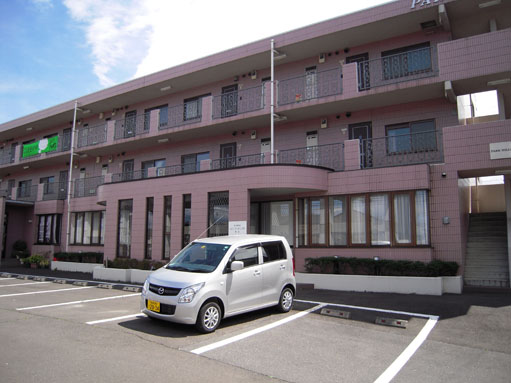
Furukawa was re-established as a branch in 2001. Missionaries first were assigned to Furukawa in the late 1970s but the small area (population 75,000) just north of Sendai has had an off-again on-again history of missionaries assigned and members meeting here. Meetings have been held since mid-2008 at this leased space at Park Hills #101, 1-7-1 Fukunuma, Ohsaki-shi, Miyagi-ken 989-6105. (map) (street view) Meetings are held in space rented on the ground floor of this apartment building, located just adjacent to the Touhoku Shinkansen elevated tracks about one mile north of the Furukawa eki (station). Elders live in one of the apartments above or nearby, I understand.
After the Higashi Nihon DaiShinSai (East Japan Great Earthquake Disaster) longer-term roudou (manual labor) Helping Hands volunteers, including some Sendai RMs, were housed in a former missionary apartment in Furukawa, due to its inland location fairly close to the tsunami-ravaged Pacific coast cities such as Ishinomaki. These volunteers were supervised by Brother and Sister Asano, a Teruya-jidai convert who lost their house near Shiogama in the disaster.
Ishinomaki
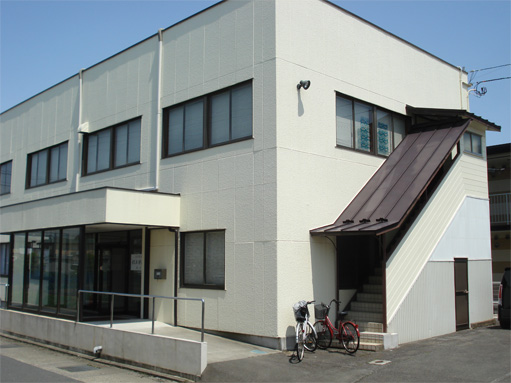
This rented building is currently used for church meetings in Ishinomaki, a coastal city east of Sendai with a population of around 150,000. Prior to 2005, only the second floor was used as the ground floor was an office building. The meetinghouse is located at Nishiyama Chou 6-39, (map) (street view) about a 10-15 minute walk from the eki. This location is right next to the Nishiki-cho neighborhood where the meetinghouse was located in the 1970s. By the end of 1976, Nishiyama-chou 6-31 was the location.
The Ishinomaki Branch meetinghouse was reportedly not severely affected by tsunami flooding from the March 2011 Higashi Nihon Daishinsai disaster, but a few members lost their houses, including Takahashi Umeko Shimai, a 1976 convert, who was rescued to high ground by her neighbors.
Izumi (Sendai)
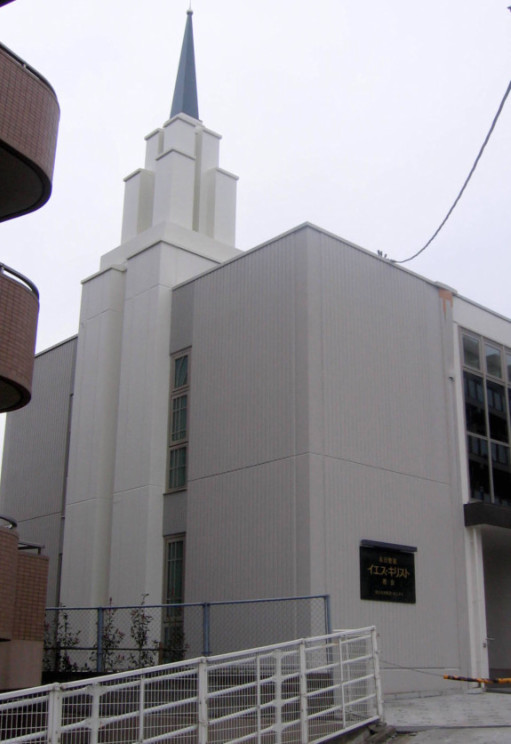
The Izumi Ward (one of three wards within the city of Sendai) is located about 5 minutes walk from the Yaotome Subway Station, the second-to-last station going north on the Nanboku (south-north) line, at Yaotome chuou 4-6-26. (map) (street view) This building was completed in 1983 and was expanded in 2006. The new steeple and elevator remodel was done in 2010. Sendai is a city of just over 1 million.
Historic Izumi/Sendai North
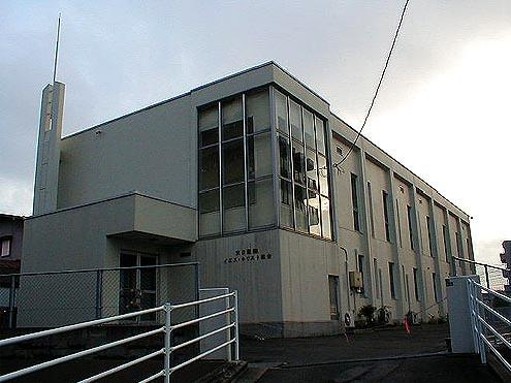
A May 2000 photo of the Izumi building, before the expansion in 2006 and steeple/elevator addition in 2010.
Missionaries first lived in this area, which was referred to as 'Sendai North,' in 1974. By the end of 1976, they lived in Izumi at Nanakitada-aza, Higashiura 153 #201 but attended church at the Kamisugi building, I believe.
If anyone has meetinghouse pictures from early mission days for Sendai North / Izumi, please Contact Us to help us complete the history.
Kamisugi (Sendai)
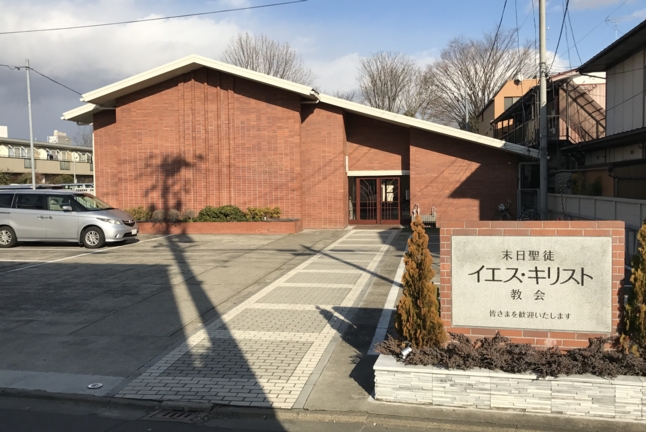
This good 'ol red brick building located at Kamisugi 1-4-5 (map) (street view) (photo taken Feb 2017) was dedicated in April 1971 and until the 1980s was the only 'church-built' meetinghouse in Tohoku. It is a 15-minute walk from Sendai JR Station. Although this building remains mostly unchanged since it was built, a few things have changed--the building in back that used to house six to ten missionaries was used for many years as the Sendai Stake offices, but I learned in 2010 that it is now used as an "outreach center" for fellowshipping activities. Sendai became a stake in November 1980. In 1974-7 we used to refer to this meetinghouse the Sendai Shibu (branch), but now it's simply referred to as Kamisugi, and houses the Kamisugi Ward. There used to be a nice tree and lawn along the entire right side (behind the new marquee sign, installed in 2016), then a covered bicycle parking area--all of which have been removed to squeeze in more cars. A very large Nihon Kirisuto Kyoudan (Japanese Church of Christ) building is now located nearby, a little closer to the eki, and undoubtedly adds some confusion to descriptions of where the church is located.
Historic Kamisugi
.jpg)
This picture was taken in 2000 when a (tacky) lighted sign and covered bike parking existed.
.jpg)
1976. Note the grass and trees, now long gone to make way for more parking.
History of Missionary Work in Sendai
Church archives say in the pre-war period, missionaries were stationed in Sendai from July 1905 to October 1907, and again from July 1922 to the mission’s closing in July 1924. Two baptisms were recorded in those years. Postwar, the first missionaries arrived in July 1949.
Kesennuma
For a short time in the 1980s, Kesennuma, a fishing town located north of Ishinomaki and south of Miyako, had missionaries and branch meetings were held. We're unsure when the branch was closed or when missionaries were moved out (1989?) but we've heard that after the branch closed, members who live in the area attended church in Furukawa or Ishinomaki. Kesennuma was badly damaged by the Daishinsai tsunami in 2011.
Nagamachi (Sendai)
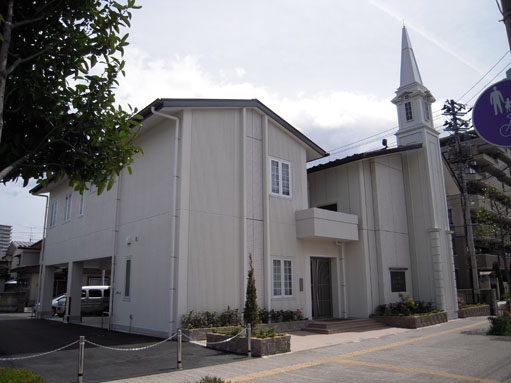
The Nagamachi Ward, dedicated in August 1990, is located on the south side of Sendai at Nagamachi Minami 1-19-30, (map) (street view) about 10 minutes walk from the second-to last station on the south end of the Nanboku (south-north) subway line, the Nagamachi Minami Station, and about 15 minutes walk from the JR Nagamachi station. The building was enlarged in late 2008 and rededicated April 2009. The remodel included adding the addition on the left, which includes an elevator and classroom, together with a new larger more traditional-looking steeple. The building was previously a tan color (see below), but when remodeled became this whiter color-a big improvement!
Historic Nagamachi / Sendai Minami (South)
At the 2009 Teruya jidai reunion, then-Mission President Reid Tateoka shared the history of how he and his companion were asked by President Teruya in 1974 to open Sendai South branch, which ultimately resulted in the Nagamachi Ward building above, where the reunion was held.
From 1974 to 1982, meetings were held both in rented buildings (Doteuchi 3-7-1, Tomizawa Azahara 21, and perhaps more) and at times members were directed to attend meetings at the Kamisugi building in Sendai proper. It appears the property at Nagamachi Minami 1-19-30 was used from 1982, perhaps in a rented building there. At some point the Church purchased the property and eventually the 'built' building was erected.
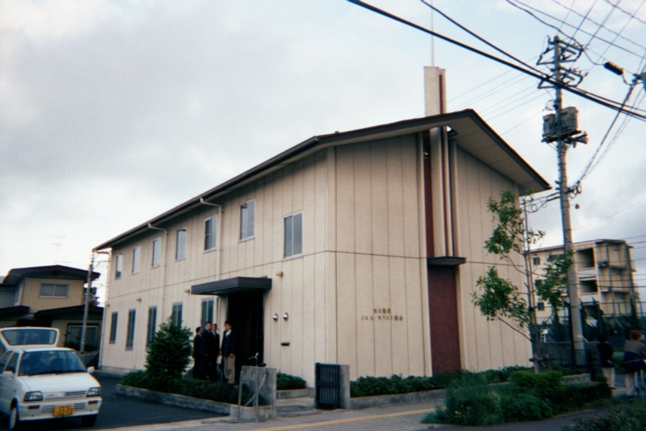 Nagamachi meetinghouse in May 2000 before 2008-9 remodel and expansion.
Nagamachi meetinghouse in May 2000 before 2008-9 remodel and expansion.Sendai South Meetinghouse at Tomizawa Azahara 21 (courtesy Jay Stott ('77-'79), taken early 1978. Jay also noted the missionaries lived in a rented house right behind the church).
If anyone has meetinghouse pictures from early mission days for Sendai South / Nagamachi, please
Contact Us to help us complete the history.
Tagajo/Shiogama
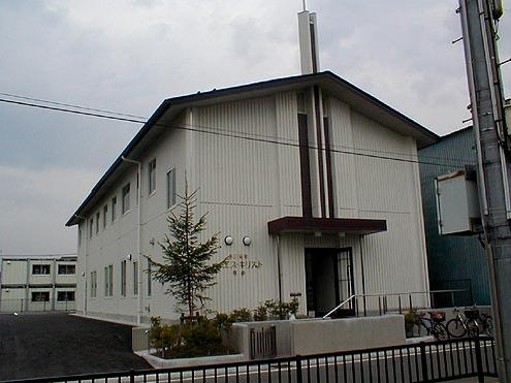
The Tagajo Ward building was dedicated in February 2001. The building is located about five minutes walk from the Tagajo eki (station) on the JRSenseki-sen (line), on the street behind a local landmark, Royal Pachinko Hall, which is shaped like a big ship. The address is Yahata 4-4-56. (map) (street view) Tagajo city and its next-door neighbor, Shiogama, are famous for nearby Matsushima (pine-islands). They are both cities of less than 100,000 people and are relatively densely populated next to the harbor that serves the Sendai area.
Tagajo's meetinghouse was the most severely damaged by the tsunami that occurred on 11 Mar 2011-not surprising since the building is located less than a mile from Shiogama Port. The building's front glass doors cracked, allowing water to flood the ground floor to a level about five feet deep. Meetings were temporarily held at the Kamisugi Ward (we called it the "Sendai Shibu") until repairs/refurbishments were completed a few months after the disaster.
Historic Tagajo/Shiogama
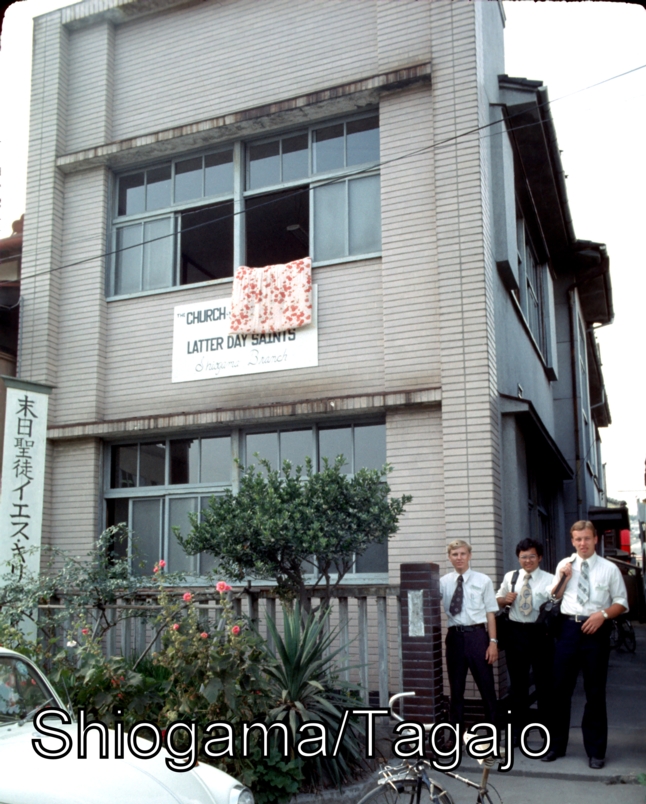 This was Shiogama's combined rented meetinghouse and elders quarters in 1976 located at Kaigandori 5-1 (map), when I was a zone leader there. Pictured are Pilcher, Carillo and Knight.
This was Shiogama's combined rented meetinghouse and elders quarters in 1976 located at Kaigandori 5-1 (map), when I was a zone leader there. Pictured are Pilcher, Carillo and Knight.According to Stuart McHardy (79-81), he heard in 1980 when he served in Shiogama that this building was heavily damaged in an earthquake. Google says one occurred in June 1978.
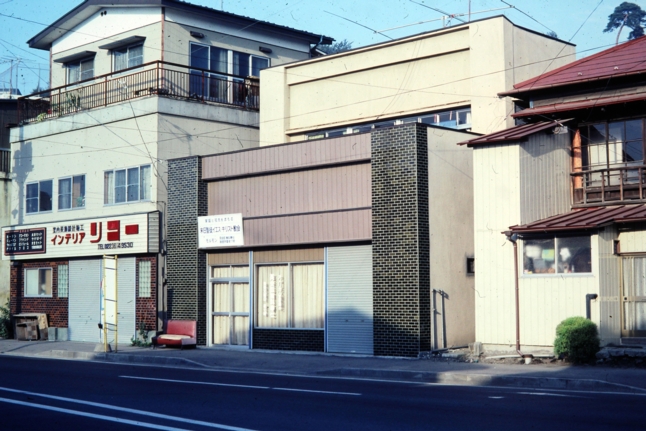
Stuart McHardy (79-81) contributed this 1980 Shiogama meetinghouse picture. The address was Kitahama 2-11-22; the building no longer stands.
Honbu
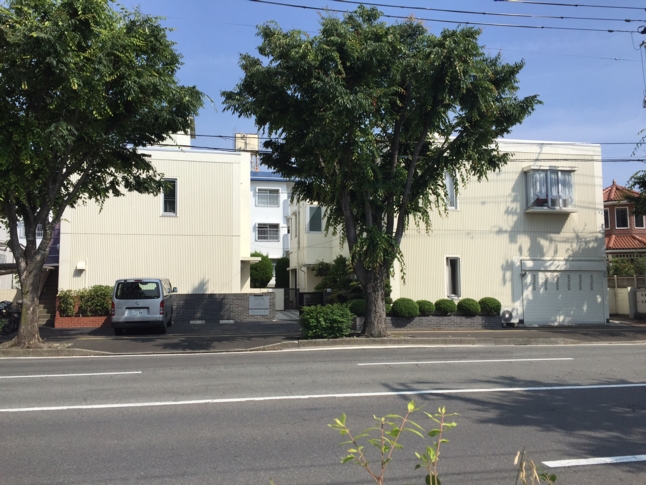
The Honbu (mission home) was completed in December 1976 after five months of construction, just six months before the first mission president Walter Teruya's three-year assignment was over. Mission offices and staff living quarters are in the building on the left. The building on the right houses the dendoubu kaichou (mission president (prior to 2006 the term dendou buchou was used)), his family and also includes guest quarters for newly arriving/departing missionaries as well as visiting church authorities. It is located near the Niseki Byoin (Japan Red Cross Hospital) down the hill from the Yagiyama zoo, at Yagiyama Minami 3-1-5. (map) (street view) The Western terminus on the touzai (east-west) subway line, which was completed in December 2015, is the Yagiyama Doubutsu Kouen, which is only about 10-15 minutes walk from the mission home (one way is downhill, one uphill). In 2016, the red brick accent around the honbu buildings was replace by a gray slate (see photo below; above photo courtesy Dan Young). When the Sendai mission was dissolved 01 Jul 2019, the Sendai honbu became the honbu of the the newly (re)created Tokyo North Mission.
Historic Honbu
.jpg)
From when the mission was created in 1974 until the new honbu was completed in December 1976, the Mission Offices occupied the far left two units on the second floor of this apartment building. Missionaries assigned to the mission offices lived in apartments on the third floor, and the mission president lived in a rented house nearby. The address is Mukaiyama 3-1-8 (Shogetsu Biru), (map) (street view) and it is located near the Yagiyama Iriguchi bus stop on the way to the permanent honbu. This picture was taken in 2000; the building still stands but was given an extreme makeover around 2012.
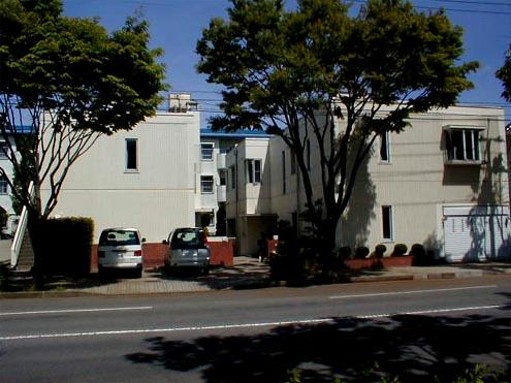
Honbu prior to 2017, when red brick accent walls were replaced with gray slate.
Links to:
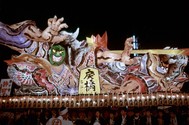





.jpg)
.jpg)

 Nagamachi meetinghouse in May 2000 before 2008-9 remodel and expansion.
Nagamachi meetinghouse in May 2000 before 2008-9 remodel and expansion.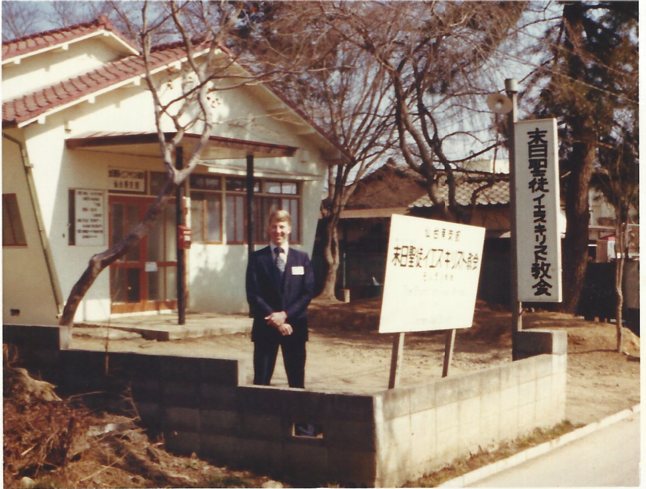

 This was Shiogama's combined rented meetinghouse and elders quarters in 1976 located at Kaigandori 5-1 (map), when I was a zone leader there. Pictured are Pilcher, Carillo and Knight.
This was Shiogama's combined rented meetinghouse and elders quarters in 1976 located at Kaigandori 5-1 (map), when I was a zone leader there. Pictured are Pilcher, Carillo and Knight..jpg)


